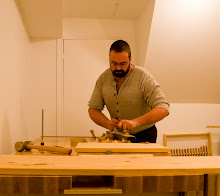
The two pieces of 2x4 have 3/4" holes bored in them. These holes fit over the round bench dogs in my workbench so that I can use my vise to pull the rig apart to test the glue. The middle piece will be glued with one 2x4 piece on each side, so that both joints (clamped and un-clamped) are pulled at the same time. The first to fail is the weaker of the two. The larger 1" hole in the central board is to allow clamping it to the 2x4 on the 'pressure' side while not clamping the non-pressure side. This way I can do both of the joints at the same time so there is no worry about one joint having an extra day to cure before the test. The joints were glued within a few minutes of one another.
In the second picture below we see the clamped side of the rig being clamped by a bar clamp tightened up as far as I could get it (should be around 500lbs of pressure) and the other side has almost no pressure - it's being done in the manner of a 'rubbed joint', so the only clamping pressure is the weight of the workpiece above (and the clamp). Total weight - less than five pounds, so it's probably less than 1% of the clamping force.
I normally use a modified PVA glue - a yellow glue - so I bought a bottle of bog-standard white PVA glue for this test.
I'll let this sit over night and then test it in the morning.

Okay, it is now the morning (time flies, eh?) and I have done the test. The un-clamped joint was the one that failed, but it tore up the wood in the process, so it didn't go terribly easily. The results can be seen below:
 I'm going to do the test one last time after planing the failed joint again to clean it up. The reason is because I want to be sure that the unclamped joint was sitting right when it dried. When I did it the first time it had the weight of the clamp hanging on one side, possibly causing problems. Today the clamped joint won't need a clamp so the unclamped joint should be a lot happier. We'll see how it goes. It will be one more data point, anyway.
I'm going to do the test one last time after planing the failed joint again to clean it up. The reason is because I want to be sure that the unclamped joint was sitting right when it dried. When I did it the first time it had the weight of the clamp hanging on one side, possibly causing problems. Today the clamped joint won't need a clamp so the unclamped joint should be a lot happier. We'll see how it goes. It will be one more data point, anyway.Okay, so I re-did the test, and once again it took a very hard pull to separate the pieces. So hard a pull that I am not really interested in trying to continue the experiments, as I fear for my bench. The non-clamped joint let go again, but again it went only with damage to both pieces so I am convinced that the un-clamped joint is more than strong enough. And remember - this was completely un-clamped. I am certain that a moderate clamping force is more than enough to make the joint far stronger than need be.
So, when next you clamp your glue joints put more effort into getting the surfaces flat rather than clamping them with tons of force.

2 comments:
It would seem to me, that once the glue joint is stronger than the surrounding wood, any greater strength is superfluous.
So, by that criteria, both your glue joints are sufficiently strong.
Mike
That may be true but if experimentation reveals time and time again that the unclamped joint is always the first to go, then there must be something else going on that affects the glue joint beyond whether or not the joint fails at the glue line. Perhaps clamping pressure causes more micro-penetration of the glue deeper into the fibers or something. I have no idea.
Charlton
Post a Comment